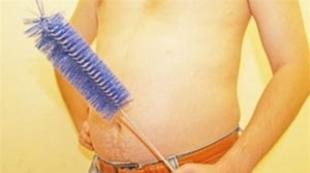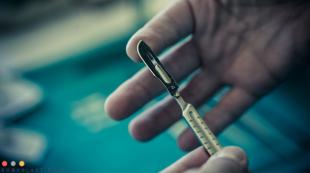Types of mousetraps. How to catch a mouse - the most effective rodent control methods
Since the owners often have to deal with mice in their home, they accordingly have to take care of their prompt removal. Some people purchase special poisons and mousetraps from specialty stores, and some are ready to make their own hands. In this article, you can learn about how to make a mousetrap with your own hands and some of its advantages.
Many people prefer to use factory-made devices that they buy in stores (glue traps, electrical, mechanical). But in general, the mechanism of operation is very simple, so a do-it-yourself mousetrap is very simple. Enough to have suitable materials to make a quality mousetrap. Some devices can be made using improvised means or material that the owners have already gathered to throw in the trash.
The advantages of this approach include the fact that the production as a whole does not take much time, you can save money if a large number of devices are required. Also, you can independently choose the size of the trap, the principle of operation and other features.
It can also be considered a plus that if the trap breaks after several uses, the owner can always fix it himself or replace it with a new one. For this reason, the question of how to make a mousetrap on your own remains relevant.
Unlike factory-made mousetraps, homemade ones usually do not pose any danger to small children or pets. No hard descent. Also, its operation does not lead to the fact that blood appears, which will scare away other rodents.
Video "How to build a mousetrap from a plastic bottle"
Video instructions for making a simple and effective mousetrap from a plastic bottle.
Types of mousetraps and technology for their manufacture
If you are interested in learning how to make a mousetrap with your own hands, this information will reveal some aspects of their creation.
Mousetraps are disposable and reusable.
Usually, plastic bottles are used to make reusable traps. It is desirable that the neck be wide, since through it the mouse falls into the container itself. The plastic bottle is placed vertically or at a slight angle. Then a bait is placed in it, which exudes a strong smell. It could be fresh cheese smoked sausage, lard, a piece of meat or peanut butter.

Also, the bottle can be placed in a horizontal position, fixing it on flat surface. Then a small hole is cut out in the base, and the bait is again placed inside. The design feature lies in its simplicity, but if a mouse gets into it, then it will not work out. The smooth surface of the plastic will not allow the rodent to cling to it, and it will constantly slide off, remaining inside.
If you check it every day, you can catch pests more often. Usually no more than 2 mice can get into the bottle. Others will not climb if they understand the danger of this place. Therefore, periodically the mousetrap needs to be checked.
Disposable traps are made from glass bottles. If the mouse got into the neck, then they will not get out again. But getting them is not easy. Therefore, the bottles are broken or thrown away with the victim.
Such traps are good because they do not kill rodents, but lock them in a small space. This is suitable for people who do not want to hurt these animals. Catching them, you can release them into the field or far away from home. But you should definitely inspect the house or apartment for holes through which they could again enter the room.

You can use a glass jar to make a mousetrap. If there is no empty jar, open the can, eat the contents, and then wash it thoroughly.
Take one liter jar, then roll it up with a lid. If you don't want to roll up, then use an adhesive backing to hold the lid in place. Then you will need to carefully cut the lid from the center to the circumference (like a cake), and bend a little corner inward to clear the way for the mouse.
Inside you need to place a piece of some product - lard, meat or cheese. It is important that he smells good, and thereby attracts rodents to him. If the mouse gets into the jar, then it will not be able to get out of there in any way - sharp teeth and the slippery glass surface of the jar will interfere with it.

A homemade trap can be made from an ordinary bucket. A bucket mousetrap is easy to make and has a simple principle. Take an ordinary bucket, make a hole in two places so that a thin steel rod or rod can be passed through them (for example, 4-5 mm in cross section). Then, on this rod, you will need to string a can of sparkling water or something similar.
It is very important that the jar rotates easily around its axis (along the rod). After that, the rod is threaded through the holes in the bucket, and fixed. You can put something from food in a jar, preferably odorous. The trap is ready. The principle of operation is as follows - the mouse wants to eat what is in the jar, and when it gets inside or on it, the jar will turn. Thus, the rodent will fall into the bucket.

A wooden mousetrap can also be made. A wooden block is taken, and then holes are drilled through which pests can crawl through. As a drill, you need to take a special one, it is used to create holes in the boards during the installation of a wooden floor and other structures.
Absolutely any type of wood that is available to you will do. After that, 4 small holes are drilled from above - two at the beginning, and 2 in the center. They should reach the main hole, a thin thread will be pulled through them.
Then you will need 2 pieces of steel wire (the first is 1.5-2 mm in diameter, the second is 0.15-0.2 mm) and a regular spool of thread. The first will become the basis, and the second will fix the first on the bar.
A spring and a bracket will be made from the wire. A thick piece on one side is wound on a round base to make a curl, and the tip itself is fixed on a wooden block. The tip is located on the back side of the trap (where there is no hole). A small hook is made at the other end.

The threads are threaded through the holes. The central thread is fixed motionless so that the mouse has to gnaw through it, getting to the food, and the outer one hangs freely. Then their ends are fixed on top of a thick wire - the central thread is a knot, and the outer one is a loop on a hook. When the mouse comes for food, it will gnaw through the thread that holds the thick wire spring. Then the loop at the beginning (which is on the hook) of the box will grab the rodent and press it.
Traps with a glue base are made using double-sided tape. A box is taken and its bottom is glued with tape. This material does not lose its properties over time. And little mice will not be able to easily get out of the trap. Food with a pronounced smell is placed in the box, and placed in a remote place so as not to frighten away rodents. In a day, you can check, select the mice caught and take them out of the house.

From the most common, but far from the most beloved household pest, the easiest way to get rid of a mousetrap: you can make it with your own hands from improvised means. Ease of operation, ease of manufacture, the ability to use unnecessary trash for noble purposes and high efficiency make it possible to classify homemade mousetraps as folk art.
How to catch a mouse in an apartment
Man is the king of nature. Therefore, with his "subordinates", he must cope easily and naturally. Especially if among the latter there are small and dangerous rodents. They may not eat so much, but through them the most severe diseases spread.
A cat knows best how to catch a mouse in an apartment. But she does not share her secrets, and besides, the cats are poorly controlled, and not very constant. That is why do-it-yourself mouse traps can give odds to any mustachioed-striped predator.
Of course, a mousetrap can be purchased at the store. But for a resident of Russia, the very idea of buying such a simple thing comes to mind only with a complete loss of creativity or after being listed by Forbes.
Important:
The mouse is a cautious but stupid animal. Don't think of him as a wise scout who can bypass disguised traps. Rodents live by instincts and this is their weak point.
Homemade mousetraps get an advantage if they are loaded with the right bait.
Mousetrap Lures
The mouse has very poor eyesight, but its sense of smell is simply phenomenal! The physiology of mice has evolved in such a way that the number of neurons in its olfactory bulb is constantly increasing throughout life. This happens due to migration from the subependymal zone of the ventricles of the brain.
The mouse is very well versed in smells, knows how to identify them and has a clear gradation in terms of their attractiveness. In critical conditions, the mouse can eat candles and soap. If you have a choice, the attractiveness of the baits should be arranged in the following sequence:
- Sunflower seeds;
- Nuts (including peanuts);
- Meat (lard);
- Bread;
- Chocolate;
If you wish, you can experiment with baits. To do this, you will need to make do-it-yourself mouse traps of the same design that use different products. After each successful operation, it is necessary to note which bait attracted the rodent.
In a couple of weeks, you will have a systematic catalog of lures.
ADVICE: baits can be combined to enhance their appeal.
Why you should make your own mousetrap
The design of homemade mousetraps is so simple that the process of making them is more like creative work. It is not as exciting as sculpture or painting, and it is very difficult to imagine yourself in the place of Rembrandt or Michelangelo. But to become like Kalashnikov or Manerheim is very easy.
The most attractive thing about making mousetraps with your own hands is the opportunity to experiment, making improvements to classic designs. At the same time, even if the change did not bring the expected effect, a catastrophe with human casualties will not happen in any case.
A mousetrap is not a plane or a submarine! Experiments are welcome.
DIY mouse traps: materials and principle of operation
You can even make a mousetrap with your own hands from the garbage that is thrown away. It just takes a little ingenuity and creativity.
Too lazy to make a mousetrap yourself?
Read our review of the best ultrasonic mouse and rat repellers. Rating of the five best models with owner reviews.
Most models of homemade mousetraps use the same principles and techniques. Depending on how to make a mouse trap, according to the principle of operation of most models, they should be divided into two categories:
- Gravity;
- Spring.
In the first case, the triggering of the trap occurs due to a change in the stability of the system, after the rodent enters the control zone (example No. 3) or its activity in the prepared place (example No. 1 and 4).
Spring models use the energy of elasticity of the working fluid (example No. 3). Moreover, the spring, in this context, the collective name. A lever with a counterweight can also act as an accumulator of elasticity energy.
The homemade mousetrap models described below show both types of construction.
DIY mousetrap from a plastic bottle
A DIY mousetrap made from a plastic bottle is extremely simple and effective. And most importantly - absolutely free.
For its manufacture, a PET bottle with a volume of more than 2 liters is required. A smaller capacity can make it difficult to trigger the trap, due to too little room for the victim to maneuver.
Step 1
The bottle is cut into two unequal parts. The height of the lower part is ⅓, and the height of the upper part is ⅔ of the total length.

In the lower part, at a distance of 4-5 cm from the bottom, a round hole is cut out, with a diameter of a 5-ruble coin.
Step 2

Opposite the entrance, with the help of a wire, a puncture is made.
Step 3

From the wire we bend the L-shaped gatehouse.
Step 4

We put the bait on the gatehouse.
Step 5

We insert the guard with bait into the puncture and lower the upper part of the bottle inside.
Step 6

The baited wire is pushed inside the bottle so that the smallest tip sticks out.
The operation of a mousetrap from a plastic bottle occurs if the mouse, having climbed through the hole inside the trap, becomes interested in the bait and starts to pull it. The holding tip of the wire will move, and the top of the bottle will drop down, blocking the exit of the rodent.
TIP: Do not screw the cap on the bottle all the way. In this case, the movable part of the bottle will fall faster due to the lack of compression effect. But you can't remove the cover completely. Since the animal locked inside can dump the bottle and get out through the neck.
We make a mousetrap from a plastic bottle according to the video
How to make a mouse trap out of a jar
For this trap, you only need a glass jar with a capacity of 3 liters or more, and a special bait. A mousetrap from a jar will function flawlessly precisely when using a certain filler - husks (husks from sunflower seeds).
In a practical sense, you don't have to do anything. It is necessary to fill the jar with a husk with a layer of 3-5 cm and put a plank to the neck, along which the rodent can quickly get to the source of the smell.
Once inside the jar, the mouse can no longer get out. And it is the husk that helps to keep it there!

Mice jump high enough. But for a good jump, you need a powerful push from a solid foundation. The layer of seed husk is very loose and mobile. It is impossible not only to push off from it, it is not even possible to stand on it. The rodent, at the slightest movement, will fail.
This design has its advantages:
- The husk does not spoil;
- Mice don't eat it;
- The product does not require cocking and can function without maintenance for some time (the duration depends on the abundance of rodents);
- Performance is maintained even at low temperatures.
A trap from a can is convenient to use in the cellar.
Homemade mouse trap from a bucket of water
The design of the water bucket mousetrap stands out from all other models in that it can be left without maintenance for several months. And with a small upgrade, it will function even during severe winter frosts.
The main part of this trap is a wire frame with a movable ladder made of plastic panel, which easily rotates inside the structure.
The dimensions of the frame will depend on the diameter of the bucket. So:
Step 1

Bend an elongated U-shaped frame 5 cm wide from aluminum wire, the length of which will be 12-15 cm longer than the diameter of the bucket. The closed end of the frame, bend at an angle of 90˚. It will fix the design.
Step 2

Make a circular loop with each of the open ends of the frame around the nail. The holding loops should be approximately in the middle of the wire stock.
Step 3

Cut a small piece of material from a plastic panel with a construction knife, so that its width is 1 cm narrower than the wire frame clearance. Stepping back 1-1.5 cm from the middle, drill (or pierce with a heated nail) a through hole in the plastic ladder.
Step 4

Insert a nail into the hole, passing it through the wire loops.
Step 5

On the open ends of the frame, put a plastic lid from the jar. It will contain bait. Pour water into a bucket, 3-5 cm layer and place a wire frame on top.
The water bucket trap is ready to go.
For efficiency, put a small plank against the bucket so that the mouse can reach the frame from the right side. Moving along the plastic ladder from the board to the source of aroma, the mouse reaches the axis of rotation. As soon as she overcomes it, the center of mass shifts, and the rodent falls into the bucket.
It is convenient to leave such a mousetrap inside for the whole winter. country house. But it needs a little upgrade! Instead of water, you need to pour oil. It does not freeze in the most severe frosts and the mice will not be able to jump out.
TIP: oil can be any, provided that its smell does not interrupt the aroma of the bait. AT ideal, it is good to pour vegetable oil that has spent its resource, which was used for deep-frying, into a bucket.
Wooden do-it-yourself mousetrap
This do-it-yourself wooden mousetrap takes only 15-20 minutes, but this model is the most complex. In it, you can install several traps at once, which will be located on one bar.
Step 4

A ring with an eyelet is made of iron wire, with a diameter of ≈ 3 cm. From an elastic steel wire, twist a three-turn spring. The free ends of the spring should be 8-10 cm long.
Step 5

From an elastic steel wire, twist a three-turn spring. The free ends of the spring should be 8-10 cm long. Opposite the eye, a harsh thread is tied to the ring. For ease of use, thread the free end of the thread into a shoe (gypsy) needle.
Step 6

The thread is sequentially threaded first into the first hole (through the cut). Then from below into the second hole and the free end is fixed with a stretch by the peg. Please note that the ring should plunge into the cut, so as not to reduce the clearance of the "mink".
More about homemade mousetraps
The models of traps given in the description are extremely primitive and easy to manufacture. But this does not reduce their effectiveness.
If you have the skill of working with a soldering iron, and you are well versed in electrical circuits, then you can make an electric mousetrap with a laser guard. True, it will be extremely inconvenient to use such a miracle, because this product has a place at the exhibition.
Mice live in residential buildings, cafes and shops all year round, but they become especially noticeable with the approach of cold weather. Species that live close to humans, but not side by side with them, may migrate closer to warmth and a source of easily obtained food.
Mice cause more damage to the human economy than rats. Although the latter are less acceptable to people, they are less likely to live directly in the residential area, preferring to be in places of collection and disposal of waste. In addition, mice can breed up to ten times a year. Most often, they interfere with people not by eating a lot, but by their omnivorous nature. Mice gnaw on food, but do not finish it, after which the product has to be thrown away. They gnaw holes in clothes and furniture, build passages for themselves through partitions and walls, leave litter everywhere. Mice are especially dangerous for electrical wiring. They can try to gnaw through it, expose the wires and close them with themselves, after which fires sometimes occur. Mice are carriers of salmonellosis and other intestinal and inflammatory infections.
How to catch a mouse
To trap a mouse in an apartment, you need to understand where and from where the rodent appears.
Unlike rats, mice look for food only at a distance of 10-25 meters from their habitat. Traps should be placed where mice are most likely to appear. Mice prefer to travel along walls and other vertical structures. Mice are very inquisitive and explore every new item placed in their feeding territory. If the mouse is not immediately caught, the device can be moved to another place, writes Michael F. Potter, an expert from the Agricultural College of the University of Kentucky.
Mice eat grains and seeds, nuts, oil, and sweets. Mice are nocturnal animals, and during the dark time of the day they are able to go out in search of food up to 30 times. Behind them they leave a black oblong dropping 0.3-1.2 cm long, due to which their recent appearance is easily disavowed.
But before proceeding with the arrangement, it is better to first spend time preventing the appearance of rodents in unwanted places. Cracks and holes over a quarter of an inch wide must be patched. Weak spots: holes for water pipes in the wall and a gap under the door. To make the room less attractive, you need to keep it clean: remove food debris. After that, the basic measures, if necessary, can be supplemented with an arrangement special means from mice.
Which is better: bullying, scaring or catching?
Mice are fought in four main ways:
- poisonous baits - rodenticides;
- ultrasonic rodent repellers;
- mousetraps (killer and live traps);
- sticky traps.
They are located as close as possible to the habitat of the mouse.
Rodenticides most often created on the basis of seeds or grains. They are sold in pharmacies and contain brodifacoum, chlorophacinone, diphacinone or warfarin as active ingredients. These substances prevent blood clotting, which is why the animal dies from internal blood loss. Carefully: Keep these anti-mouse products away from children and pets.
Ultrasonic repellers act humanely for animals and are safe for you. Some models, like the budget domestic "ElectroKot Turbo", in addition to ultrasound, also affect rodents with the help of sound signals and flashes of light. This combination is much more effective - mice will definitely not have the desire to stay next to such an aggressive stimulus. In the early days of using the repeller, you may notice even more rodents than before - but this is normal. The fact is that the sudden appearance of ultrasound causes panic in rodents - as a result of which abnormal daily activity and chaotic rushes around the house may appear. As a rule, within two weeks the rodents will leave.

When there are few mice in the house, it is worth trying to catch them in mousetraps. These traps should also be kept away from pets and children. The mousetrap has undeniable advantage in front of poisonous bait. The mouse will be immediately removed from the house, while the poisoned and dead mouse will remain lying somewhere, for example, in the cavity of the wall and floor and exude bad smell. Traps are placed along the walls where mice or traces of their vital activity were seen. The trap rotates perpendicular to the wall, but some instructions recommend placing it parallel. In addition to the murderous ones, there are also live traps, which allow the captured mouse to be released without harming it.
sticky traps also effective against mice, unlike heavier and stronger rats. Running along a familiar path, the mouse suddenly finds itself on a sticky surface, from which it can no longer escape. If the trap accidentally sticks to a person or pet, it can be removed with vegetable oil.
All traps should be checked daily for dead mice. Perform all work with gloves.
Which mousetrap is better? How They Work: An Overview of Trap Types
Behind large quantity designs and manufacturers hide only four types of mouse traps, and we will now analyze them.

Ordinary mousetraps. The simplest and most familiar type of trap to us from childhood or from cartoons. The cheapest is the classic wooden mousetrap with an iron bracket. A bait is pricked on the “fishing rod”, to which the mouse comes. As soon as she tries to take the food with her, the bracket will slam shut and squeeze her. The mechanism is quite strong and can kill an animal or injure a person who carelessly handled it.
In addition to wooden ones, plastic and metal ones are now being produced, which can look significantly different from the classic model, but retain the same principle.
"Live" traps. This trap does not kill the rodent but only keeps it in a small enclosure. Suitable for those for whom the killing of an animal, even a pest, is unacceptable. The captured mouse is simply released away from home. In addition, it can be shown to children in this way and taught them humanism by their own example.
Glue traps for mice. Effectively solve the problem: how to catch a mouse without a mousetrap. They are boards, trays or slats with glue. They effectively trap mice, although they are unlikely to keep rats for long. Their disadvantage is in action. A mouse that has fallen on the glue, trying to get out, starts to twitch and squeak violently, creating noise. The glue is non-toxic and will not kill a rodent, but if a mouse gets trapped at night, you will have to get up and do something about it, because it will be difficult to fall asleep under the squeak.
Electronic traps for mice. The most effective trap was invented relatively recently. The advantages of an electronic device are obvious: a mouse or a rat runs into the trap in search of food and receives a current discharge, dying quickly and painlessly. Perfectly solves the problem: how to catch a mouse in a house without blood and mess. In addition, electronic traps are convenient and practical for large premises and food warehouses, as they can be used without recharging for a long time.
| Type of mousetrap | Advantages | disadvantages |
| common mousetrap | very cheap | does not kill quickly |
| "Live" trap (live trap) | cheap and don't kill | you need to take away and release the mouse |
| glue trap | cheap | the mouse can squeak and swarm for several days |
| kill quickly with an electric discharge, without blood or dirt, the charge is enough for a hundred electric shocks | expensive, do not use outdoors without special protection against water |
What is the difference between mouse and rat traps?

Rats are heavier, stronger and smarter than mice. Therefore, ordinary or sticky traps that are suitable for catching mice are not suitable for them. They can work together to steal bait from a mechanical trap.
Glue traps can trap mice or young rats. Mature rodents from among the latter will be able to get out of it within one or two hours.
At the same time, if there are no problems with rats in a small apartment, and mice are wound up, it makes no sense to buy an expensive electronic trap, which undoubtedly has important advantages (we will talk about them below), but is designed for long-term use with a large number of charges and not particularly needed where you want to catch 2-3 rodents.
Mousetrap bait or how to lure a mouse
Domestic rodents prefer grains and cereals, as well as nuts. But scientists from the University of Kentucky note the diversity of the diet of domestic rodents, in which cereals are only the basis:
Mice eat a variety of foods, but prefer seeds and grains. They also like foods that are high in fat and protein, such as nuts, bacon, butter, and sweets ( important point to remember when choosing bait to snap traps). Mice can make 20-30 sorties per night.

A popular bait among mousetrap users is peanut butter bait, which is convenient to use due to its consistency, making small balls or smearing it on the sensory surface of the mousetrap. Contrary to popular myth, they are not crazy about cheese and eat it on par with other foods. So cheese is not always a good bait.
As Michael F. Potter mentioned above joked, you have to think like a mouse. Better use smoked lard or bacon. In addition to peanut butter, unrefined sunflower oil is suitable. They can wet a piece white bread. Or just put roasted sunflower seeds or peanut kernels in a mousetrap.
Top 6 Mouse Traps
Steel mousetrap "FIT"
 Most classic version mousetraps: wooden base with durable steel mechanism. It has maximum sensitivity, which makes it impossible to steal the bait - it slams shut instantly! It is these traps that are most popular among the people: they are cheap (2 FIT traps cost only 69 rubles) and always work flawlessly.
Most classic version mousetraps: wooden base with durable steel mechanism. It has maximum sensitivity, which makes it impossible to steal the bait - it slams shut instantly! It is these traps that are most popular among the people: they are cheap (2 FIT traps cost only 69 rubles) and always work flawlessly.
But they also have their obvious disadvantages. So, this is not the fastest and most sparing option for killing: the mouse may not die immediately, but suffer from pain for several hours. Also, the tree absorbs the smell of dead animals, so after a while the mice will understand the catch and will not climb into it anymore - it will have to be changed to another one. But such devices are so budgetary that buying a new one is not a problem. The main thing is that they work and have been tested by millions of people.
Plastic mousetrap "Mr.Mouse".
 Another variation of the classic mousetrap with an improved design of the bait spot. It is made of plastic, which does not get dirty, unlike wood, and does not absorb odors. Therefore, the mousetrap can be used many times without fear that it will start to smell like dead rodents. It is also safer than steel traps, because. works on the principle of a large clothespin - your fingers will be intact. Contrary to popular belief, mice don't like cheese that much, so use seeds, peanuts, chocolate, or dry pet food as bait. Users write -
Another variation of the classic mousetrap with an improved design of the bait spot. It is made of plastic, which does not get dirty, unlike wood, and does not absorb odors. Therefore, the mousetrap can be used many times without fear that it will start to smell like dead rodents. It is also safer than steel traps, because. works on the principle of a large clothespin - your fingers will be intact. Contrary to popular belief, mice don't like cheese that much, so use seeds, peanuts, chocolate, or dry pet food as bait. Users write -
Mr. Mouse is very easy to use, pulling out mice is extremely easy, and it's not scary that you leave your fingers there - I recommend it to everyone.
Price - about 80 rubles.
Glue trap “Gryzunoff”
 A simple and inexpensive option for those who need to catch a small number of rodents. According to the manufacturer, the trap is designed to catch gray and black rats, house mice, gerbils, bank voles and moles. The sticky base is non-toxic and, in addition to glue, contains rosin, rubber and mineral oils. But it is more likely just for mice - such a surface is unlikely to hold large rats. Keep in mind that if stuck in the adhesive base, mice may try to get out of it by tearing off their limbs. The sight is not pleasant, so it is better to check them more often and finish off the rodents or release them. It costs from 100 rubles.
A simple and inexpensive option for those who need to catch a small number of rodents. According to the manufacturer, the trap is designed to catch gray and black rats, house mice, gerbils, bank voles and moles. The sticky base is non-toxic and, in addition to glue, contains rosin, rubber and mineral oils. But it is more likely just for mice - such a surface is unlikely to hold large rats. Keep in mind that if stuck in the adhesive base, mice may try to get out of it by tearing off their limbs. The sight is not pleasant, so it is better to check them more often and finish off the rodents or release them. It costs from 100 rubles.
Mouse trap “House”
 This is a humane option for trapping: the trap does not kill mice, but simply locks them inside - rodents have no chance to get out. Such a “House” looks like a plastic tube, bent at a certain angle, and two doors. Before starting work, you must remove the back cover and put in the far part of the device favorite treat mice - peanuts, seeds or dry pet food. Then place it on a flat surface, close the back cover and open the front door - especially for rodents. When he crawls to the bait, the "House" will automatically slam shut.
This is a humane option for trapping: the trap does not kill mice, but simply locks them inside - rodents have no chance to get out. Such a “House” looks like a plastic tube, bent at a certain angle, and two doors. Before starting work, you must remove the back cover and put in the far part of the device favorite treat mice - peanuts, seeds or dry pet food. Then place it on a flat surface, close the back cover and open the front door - especially for rodents. When he crawls to the bait, the "House" will automatically slam shut.
Do not forget to check such traps in a timely manner - so that the mouse does not die inside! Set her free and lay her down new portion bait, then install again. The method is not only humane, but also affordable: for ~ 250 rubles. you can purchase 4 “Houses” at once.
Electronic exterminator of mice and rats "EcoSniper GH-190 Rat Killer"
 EcoSniper is an example of the fastest way to get rid of rodents: it kills mice with an electric shock in five seconds. This electronic trap can work both from a network, and from batteries. The design of the trap ensures the safety of children and pets. It can be used to catch any rodents in the house, garage and any other room. When using batteries, you can even set it up outdoors - as long as you make sure the trap is protected from water. But such powerful devices cost much more than usual ones - from 3000 rubles.
EcoSniper is an example of the fastest way to get rid of rodents: it kills mice with an electric shock in five seconds. This electronic trap can work both from a network, and from batteries. The design of the trap ensures the safety of children and pets. It can be used to catch any rodents in the house, garage and any other room. When using batteries, you can even set it up outdoors - as long as you make sure the trap is protected from water. But such powerful devices cost much more than usual ones - from 3000 rubles.
Live trap “Cage”
 This cage trap is made of galvanized steel and has a wooden bottom. It is safe for children and animals, including mice themselves, and is suitable for those who do not want to kill animals, even harmful ones. Once in a cage-trap, the mouse remains locked in it, but unharmed. A caught rodent just needs to be released into the wild by opening the door away from your home. Some people prefer to place poison inside the trap, but we do not recommend doing this - it's better to just catch and release the animal. The compact size of the cage allows it to be used anywhere - outdoors or indoors. Such a device costs from 350 rubles.
This cage trap is made of galvanized steel and has a wooden bottom. It is safe for children and animals, including mice themselves, and is suitable for those who do not want to kill animals, even harmful ones. Once in a cage-trap, the mouse remains locked in it, but unharmed. A caught rodent just needs to be released into the wild by opening the door away from your home. Some people prefer to place poison inside the trap, but we do not recommend doing this - it's better to just catch and release the animal. The compact size of the cage allows it to be used anywhere - outdoors or indoors. Such a device costs from 350 rubles.
| Product | Type | Operating principle | Price |
| Steel mousetrap "FIT" | ordinary | Slams on the body of the mouse | ~69 RUB (2 pieces) |
| Plastic mousetrap "Mr.Mouse". | ordinary | Slams on the body of the mouse | ~80 rub. |
| Glue trap “Gryzunoff” | sticky (adhesive) | The rodent gets stuck in the sticky layer | from 100 rub. |
| Mouse trap “House” | live trap | ~250 rub. (4 pieces) | |
| Electronic trap "EcoSniper GH-190 Rat Killer" | electronic | Kills the mouse electric shock | ~3000 rub. |
| Live trap “Cage” | live trap | The rodent falls into the trap unharmed | from 350 rub. |
Rodents are carriers of dangerous infections. In addition to aesthetic inconvenience, they pose a danger to the health of children and pets. There are a wide variety of mouse traps available in stores. However, there are times when there is no time to search for the necessary mousetrap or there is not enough money to buy them. In this case, self-made devices will come to the rescue, which are not inferior in quality to store designs. How to make a mousetrap with your own hands? You will find the answer to the question in the article.
Advantages of homemade mousetraps
Ready-made traps differ in the principle of operation. Some hold or kill the mouse, others scare it away with ultrasound. The use of certain types of traps is unacceptable if there are pets and children in the house who may accidentally fall into a trap or be poisoned by the chemicals used.
The main advantages of homemade mousetraps:

How to prepare bait?
The most sophisticated trap, thought out to the smallest detail, does not guarantee that the rodent will be caught. The main thing in a mousetrap is the right bait. Pay attention to the location of the trap, the access routes to it must be open so that the mouse can easily get to the treat. There is a well-known stereotype imposed by cartoons that mice are crazy about cheese. In fact, things are a little different. Rodents really love this product, but catching a mouse on such a bait will be quite problematic. As a bait, it is better to use:
- a piece of smoked lard or sausage;
- white bread crackers;
- sesame;
- bread soaked in sesame oil;
- sunflower seeds;
- peanut.
The aroma of products will attract the attention of mice and lure them into a prepared trap. It is worth noting that the smell of unrefined sunflower oil can kill the smell of a person, so they need to lubricate the trap before use.
The bait in the mousetrap should be changed periodically, because, sensing danger, the mouse stops responding to the aroma that is attractive to it.
Homemade trap from a can and a coin
A mousetrap from a can is suitable for those who are not ready to kill rodents. The mouse will be trapped, while its state of health will not be disturbed. To make a trap, you will need a jar (you can use a saucepan) and a coin or a button.
The edge of the jar is lifted and placed on a coin, which serves as a support. The hook with the bait is fixed inside the container with a thread. A delicacy for rodents is best placed at a distance of 2-4 cm from the surface. This achieves greater efficiency of the device.
The thread is fixed on the rod, which is installed in the middle of the can. A branch or wire can be used as a rod. The principle of operation is to pull the thread and pull out the support from under the jar after the mouse tries to get a treat while inside the jar. The jar covers the rodent and keeps it in a trap (look at the video).
The main drawback is the lack of automatic reloading. After catching one mouse, the device must be reinstalled. To get a caught rodent, place a thick sheet of cardboard or a flat plate under the structure. To facilitate the design of the mousetrap, instead of a rod and a thread, you can stick the bait on the wall of the can with your own hands. When the mouse touches it, the structure will lose balance and the rodent will be trapped.
Can and paper trap
A can and paper mouse trap is an easy way to catch a pest. To make a mousetrap, you will need a deep container, a sheet of paper, an elastic band and a knife (razor).
A sheet of paper is placed on the neck of the jar, the edges of which are folded down and tied with a thread or fixed with a rubber band. In the center of the hole you need to make an incision with a razor and sharp knife"Cross to Cross". The bait is placed in a container or hung over a jar at a short distance. If you use a light weight treat, you can put it on paper. In order for rodents to get to the bait, a special bridge should be installed connecting the surface to the upper edge of the container.

 As soon as the mouse hits the center of the paper, its edges will move apart under the weight of the pest and the rodent will fall into a trap. In order to prevent exit from the trap, water can be poured into the container. This method is not very effective, as mice sense danger and do not go to the center of the paper. As a rule, young individuals come across in the adaptation.
As soon as the mouse hits the center of the paper, its edges will move apart under the weight of the pest and the rodent will fall into a trap. In order to prevent exit from the trap, water can be poured into the container. This method is not very effective, as mice sense danger and do not go to the center of the paper. As a rule, young individuals come across in the adaptation.
How to catch a mouse with a bucket and a ruler?
The design feature is the interchangeability of the main elements. Instead of a bucket, you can use a pan or other deep container; instead of a ruler, a flat thin rail is used.
For manufacturing, it is necessary to securely fasten a wire or knitting needle to the bucket. You can make holes in the plastic container on both sides and push the wire through them. The ruler should be placed on one edge of the bucket and wire so that the longer length of the rail remains suspended. The bait must be placed on the far edge of the ruler. Then you should build a special "ramp" so that the mouse can climb to the treat.
Smelling a pleasant aroma, the rodent will go along the rail. Having passed through the intersection of the ruler and the wire, the pest will change the gravity of the structure, the ruler will turn over, and the mouse will be trapped. If you fix the bait in such a way that it does not fall into the bucket along with the rodent, you get a reusable mousetrap with your own hands. To prevent the pest from getting out, you can pour water into the container.
 There is an easier way to make a mousetrap using a bucket and ruler. On the edge of the table you need to put a thick sheet of cardboard or plain paper, placing a ruler under it (see photo). Place a bucket or other deep container of water under the surface. Attach the bait to the edge of the cardboard. The mouse will go to the smell of treats and turn the structure over with its own weight. When fixing a ruler with a table and a bait, a reusable design is obtained, with which you can catch several pests.
There is an easier way to make a mousetrap using a bucket and ruler. On the edge of the table you need to put a thick sheet of cardboard or plain paper, placing a ruler under it (see photo). Place a bucket or other deep container of water under the surface. Attach the bait to the edge of the cardboard. The mouse will go to the smell of treats and turn the structure over with its own weight. When fixing a ruler with a table and a bait, a reusable design is obtained, with which you can catch several pests.
Plastic bottle traps
Plastic bottle mousetraps are easy to make and effective. There are several types of structures that can be built at home.
From a plastic bottle, you need to cut off the neck (threaded part). For ease of action, you can use a clerical knife. On one edge of the container, make a hole with an awl and insert a thick thread into it, which should be securely fixed. One end is attached to the bottle, the other - to the table (to a nail or self-tapping screw) or a pan. The length of the thread should keep the bottle hanging. The bait is placed at the bottom of the container.
The bottle is placed horizontally on the edge of the table so that the bait is suspended. The mouse will try to get a treat and go inside the bottle to its bottom. Under the weight of the rodent, the center of gravity of the structure will shift, and the bottle will fall. The mouse will be trapped, like in a house.
For the second method, you will need plastic bottle and bait. Even a schoolboy can make such a trap. It is necessary to cut the bottle into 2 parts (the part with the bottom should be larger). The other part is turned over so that the neck is inside the bottle. The bait is placed at the bottom, the neck is lubricated vegetable oil. To securely fix the structure, you can fasten the parts of the bottle with thread, wire or tape. The mouse will easily get to the bait through the greased neck, but will not be able to get back.
Glue traps
In such traps, special glue is used as the main element, which can be purchased at hardware stores. The method consists in applying glue to cardboard or plywood, in the center of which is the bait. Once on the adhesive surface, the mouse cannot get out and dies.
Glue traps are not humane, since the death of a rodent can be long and painful, it is impossible to peel off the pest from the composition.
For the convenience of using glue mousetraps, you can build a reusable trap. To do this, you need a shoebox in which a hole is made for mice. In the box under the hole, a cardboard with glue is installed, and in the center - a bait. The pest will fall into the trap, smelling the smell of goodies.
Glue traps are best made with rubber gloves, avoiding contact with exposed skin. If there are small children and pets in the house, it is better to refuse this method. The most suitable method is an electric trap. An electrical device guarantees the safety of family members and pets.
Mice are the oldest neighbors of mankind. Rodents are to blame for many epidemics, as they are able to carry deadly diseases. Modern medicine has gone far ahead, but some ailments can still seriously harm a person. The appearance of mice in the house is a real misfortune. Pests must be dealt with immediately.
It is not necessary to kill the rodent, there are many humane ways to help catch the pest, release it at a safe distance from your home. At home, you can make tricky traps. They are safe for pets, small children, but are highly effective.
Causes of mice in the house

Despite their outer shell, mice are quite intelligent animals. They penetrate small cracks, run through sewer, ventilation pipes, are able to run into opened window or a door. Some individuals easily bypass intricate traps, sometimes survive after persecution, even develop immunity to commonly used poisons. To successfully catch gray pests, stock up on ingenuity and patience.
The human dwelling includes several important aspects necessary for the reproduction and normal functioning of pests:
It is very simple to suspect the presence of mice in the house, it is enough to notice some aspects:
- gnawed bags of cereals;
- the presence of rodent feces on the floor, near the accumulation of food;
- bad smell;
- at night, the appearance of rustles, noise, squeak is noted. During the day, rodents hide in secluded places, so their presence is hardly noticeable.
Finding roommates deal with them immediately. To do this, use time-tested traps, folk remedies. It is not necessary to spend money on expensive poisons that can adversely affect human health, pets, even indoor plants.
Harm caused by gray rodents

Rodent danger:
Homemade traps: how to make and use
This opinion is absolutely wrong. Rodents prefer pieces of sausage, bread, grain, which is watered with sunflower oil. Seeds are very popular among gray pests; you will definitely catch a big “catch” for this product. Modern mousetraps are compact, lightweight, but have a significant drawback - the mouse suffers before death, which is not very humane. Also, the trap is designed for only one animal, it will not work to catch another individual.
Note! Homemade mouse traps are absolutely safe, the captured animal can be released, the product can be used many times. In addition, traps made at home are made from improvised materials, you do not need to spend money on their production.
Catching a rodent with a can

Use cases:
- option number 1. You will need a bucket or any other large container, a plastic bottle (0.5), a wooden stick, bait. Insert a stick into the bottle so that it pierces the bottom and neck of the product. Place the bottle in such a way that the ends of the stick are fixed on the edges of the bucket. Put the bait on top of the bottle. The mouse will try to eat it, stepping on the bottle, it will scroll, the rodent will remain in the bucket;
- method number 2. Place a bucket under a stool, put a piece of light wood in the form of a strip on it. Put the product in the form of a springboard, put a tidbit on the edge above the bucket. The wooden plate will not be able to support the weight of the bait and the rodent, it will fall down into the bucket, and the rodent itself will be trapped along with it.
Glue against pests
Hardware stores sell special types of glue designed to catch rodents. Spread the product on a flat surface, the mouse will get stuck in it during the examination of the glue, it will no longer be able to get out. The glue trap for mice is not suitable if there are small children or pets in the house.
Plastic bottle

Effective Recipes folk remedies from cockroaches in the apartment are described on the page.
Go to the address and learn about how to deal with midges in the kitchen.
Helpful Hints:
- store all cereals, sugar in a glass container with a tight-fitting lid. Regularly inspect your supplies, the presence of strange objects, small lumps of black is a sure sign of the presence of living creatures in the house;
- Remove plastic bags from the kitchen. All food stored in them is potential food for rodents;
- put several cloves of garlic, bay leaf or onion peel into kitchen cabinets. Specific aromas will repel mice;
- garbage cans should be placed as far as possible from the residential building. Empty the trash can regularly;
- hang a birdhouse near the house, attract with crumbs birds of prey. For example, one barn owl is able to catch up to seven rodents per night;
- wash all surfaces with a solution of water and chlorine (take a tablespoon of powder per liter of liquid). A strong aroma will scare away uninvited guests;
- mice do not like space and lack of trash. Maintain cleanliness and order in the apartment, private house, eliminate all secluded places. So you make your home unsuitable for rodents.
Mice are smart animals, able to multiply quickly and harm a person. Homemade traps will help to deal with uninvited guests. Follow the instructions for their manufacture, adhere to preventive measures.
From the following video you can learn how to make a mouse trap with your own hands in a few minutes:









